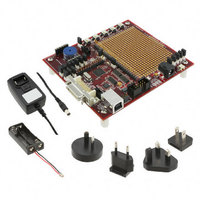EM260-BBRD-128K-USART-R Ember, EM260-BBRD-128K-USART-R Datasheet - Page 16

EM260-BBRD-128K-USART-R
Manufacturer Part Number
EM260-BBRD-128K-USART-R
Description
EM260 BREAKOUT BOARD
Manufacturer
Ember
Type
Transceiver, 802.15.4/ZigBeer
Datasheet
1.EM260-RCM-USART-R.pdf
(54 pages)
Specifications of EM260-BBRD-128K-USART-R
Frequency
2.4GHz
For Use With/related Products
EM260
Lead Free Status / RoHS Status
Lead free / RoHS Compliant
Other names
636-1026
4.2
4.3
120-0260-000J
Transmit (TX) Path
Integrated MAC Module
seen in range testing measurements when nodes are closely positioned and transmitting at high power or when
receiving from test equipment. There is no damage to the EM260 from this problem. This issue will rarely
occur in the field as ZigBee Nodes will be spaced far enough apart. If nodes are close enough for it to occur in
the field, the MAC and networking software treat the packet as not having been received and therefore the
MAC level and network level retries resolve the problem without needing to notify the upper level application.
The EM260 transmitter utilizes both analog circuitry and digital logic to produce the O-QPSK modulated signal.
The area-efficient TX architecture directly modulates the spread symbols prior to transmission. The
differential signal paths increase noise immunity and provide a common interface for the external balun.
4.2.1
The EM260 TX baseband (within the digital domain) performs the spreading of the 4-bit symbol into its IEEE
802.15.4-2003-defined 32-chip I and Q sequence. In addition, it provides the interface for software to perform
the calibration of the TX module in order to reduce process, temperature, and voltage variations.
4.2.2
Even though the EM260 provides an output power suitable for most ZigBee applications, some applications will
require an external power amplifier (PA). Due to the timing requirements of IEEE 802.15.4-2003, the EM260
provides a signal, TX_ACTIVE, to be used for external PA power management and RF Switching logic. When in
TX, the TX Baseband drives TX_ACTIVE high (as described in Table 6). When in RX, the TX_ACTIVE signal is
low. If an external PA is not required, then the TX_ACTIVE signal should be connected to GND through a 100k
Ohm resistor, as shown in the application circuit in Figure 14.
The TX_ACTIVE signal can only source 1mA of current, and it is based upon the 1.8V signal swing. If the PA
Control logic requires greater current or voltage potential, then TX_ACTIVE should be buffered externally to
the EM260.
The EM260 integrates critical portions of the IEEE 802.15.4-2003 MAC requirements in hardware. This allows
the EM260 to provide greater bandwidth to application and network operations. In addition, the hardware acts
as a first-line filter for non-intended packets. The EM260 MAC utilizes a DMA interface to RAM memory to
further reduce the overall microcontroller interaction when transmitting or receiving packets.
When a packet is ready for transmission, the software configures the TX MAC DMA by indicating the packet
buffer RAM location. The MAC waits for the backoff period, then transitions the baseband to TX mode and
performs channel assessment. When the channel is clear, the MAC reads data from the RAM buffer, calculates
the CRC, and provides 4-bit symbols to the baseband. When the final byte has been read and sent to the
baseband, the CRC remainder is read and transmitted.
The MAC resides in RX mode most of the time, and different format and address filters keep non-intended
packets from using excessive RAM buffers, as well as preventing the EM260 CPU from being interrupted. When
the reception of a packet begins, the MAC reads 4-bit symbols from the baseband and calculates the CRC. It
assembles the received data for storage in a RAM buffer. A RX MAC DMA provides direct access to the RAM
memory. Once the packet has been received, additional data is appended to the end of the packet in the RAM
buffer space. The appended data provides statistical information on the packet for the software stack.
The primary features of the MAC are:
•
•
•
•
TX Baseband
TX_ACTIVE Signal
CRC generation, appending, and checking
Hardware timers and interrupts to achieve the MAC symbol timing
Automatic preamble, and SFD pre-pended to a TX packet
Address recognition and packet filtering on received packets
Page 16
EM260























